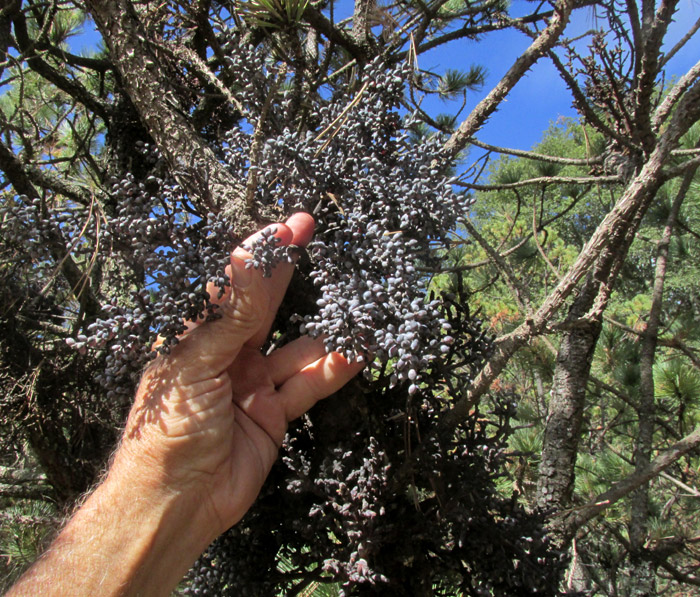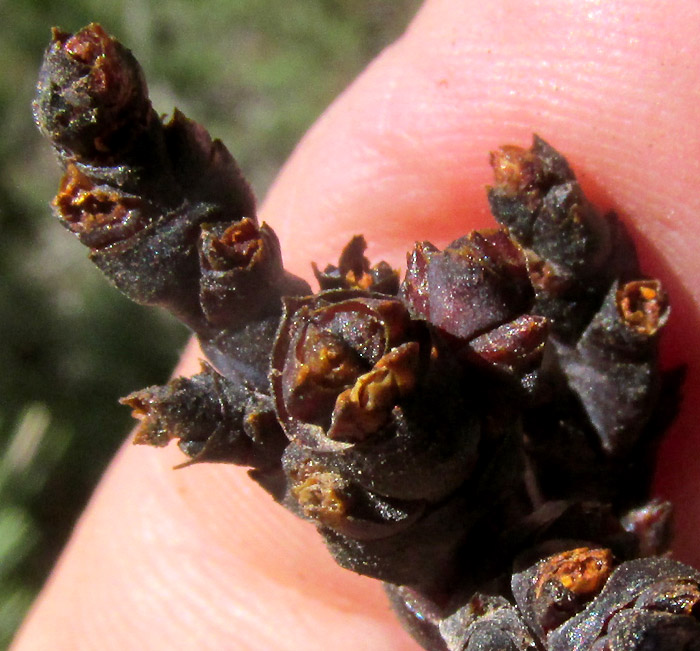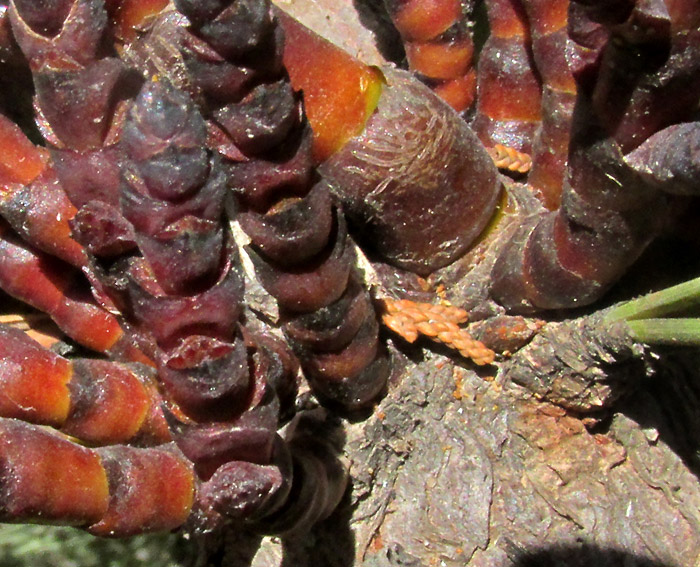Excerpts from Jim Conrad's
Naturalist Newsletter
Entry from field notes dated June 29, 2023, taken along one-lane gravel road in valley between Puerto del Zenthé and Chavarrías in mountainous area with a maze of roads too complex to say how to get there; in general it's in the mountains of east-central Querétaro state, municipality of Cadereyta de Montes, 12 straight-line kms due east of Vizarrón de Montes but much farther by twisting roads; juniper-scrub forest; limestone bedrock; elevation ~2840m (~9300 ft), Querétaro, MÉXICO, (N20.84604°, W99.60655°)
DWARF MISTLETOE

On the valley floor along the one-lane gravel road, a certain area was inhabited by Teocote Pines of such similar heights, about 6m tall (20ft), that I suspected they'd been planted, maybe as a reforestation project. Several young trees were parasitized by heavily fruiting mistletoes, shown above.

This wasn't the usual kind of Christmas Mistletoe northerners think of, because it was purplish black and bore no green leaves. Also, its fruit -- the glossy item seen above in the picture's center -- was dark purplish, not white, and coated with a frosty silveriness, or glaucescence. During my days in the western US I learned that -- at least in that part of the world -- mistletoes with scalelike leaves and fruits produced at the ends of curved stalks, or pedicels, were dwarf mistletoes, of which several species were known. Dwarf mistletoes belong to the genus Arceuthobium. On the dwarf mistletoe shown above, technically, the leaves are the pudgy, triangular, scale-like appendages appearing opposite one another in pairs at stem nodes.

Several branch tips bore the above clusters of brown items, which I assume to be flowers in an early or late stage of blossoming. In Arceuthobium, flowers are produced in the axils of the scales, not in stem cavities or grooves as in most northern mistletoes. Flowers are unisexual, the sexes appearing on different trees (dioecious). Blossoms bear no sepals, but produce 2-4(-6)tiny petals. To my unpracticed eye, above it seems that some of the brown, papery items grow atop spherical structures that could be developing ovaries or fruits, but really I'm not sure what's seen above.

Above you see our plant's stems entering the Teocote Pine's stem. Mistletoes don't have regular roots, but rather rootlike haustoria, which penetrate the host's tissues to absorb water and nutrients.
About 26 dwarf mistletoe species are known worldwide. The 2011 treatment of the genus Arceuthobium in the Flora del Bajío documents five species in central upland Mexico. Dwarf mistletoe species parasitize only trees of the Pine Family, the Pinaceae, and the Cypress Family, the Cupressaceae, and individual dwarf mistletoe species parasitize only certain species of pine or cypress. To identify our plants to species level it was very helpful to know that it grew on Teocote Pines.
In our part of Mexico, if you have a dwarf mistletoe growing on Teocote Pine, the whole mistletoe is dark blackish as opposed to yellow, orange or pale greenish-brown, and its fruits also are entirely black or dark purplish, you have ARCEUTHOBIUM VAGINATUM subspecies VAGINATUM.
Often a species' subspecies are so similar to one another and with intermediate forms that it's hardly worth mentioning them. In this case it's important to emphasize that our blackish plants are the "typical" form -- the form first collected, from which the species originally was described -- the subspecies vaginatum. Mentioning the subspecies is important because if you search for pictures of Arceuthobium vaginatum on the Internet, the vast majority of the plants you'll see will be yellow or orangish plants. Those are mostly subspecies cryptopodum of the south-central US south. English speakers often call that form Southwestern Dwarf Mistletoe. Our subspecies vaginatum occurs throughout the Mexico uplands south into Honduras. The Flora del Bajío says that our dark purple form is typical in this area, while in other parts of Querétaro state they may vary from blackish to pale brown.
Our central Mexican plants are the "typical" vaginatum subspecies because the species was first collected scientifically in this area, by Humboldt and Bonpland during their Mexican expedition of 1803 and 1804. The now-better-known US subspecies cryptopodum wasn't recognized as something else until it was published by the German-American botanist Georg Engelmann in 1850 as a new species. Then in 1965 Hawksworth & Wiens demoted that species to subspecies level within the preexisting Arceuthobium vaginatum.
In fact, mistletoe classification is notoriously poorly understood, and in a state of flux. That's largely because during their evolution mistletoes lost many physical traits used in classical taxonomy, yet modern genetic studies haven't been completed. At this writing, the Flora of North America assigns our dwarf mistletoe genus Arceuthobium to what it calls the Christmas Mistletoe Family, the Viscaceae. However, the Angiosperm Phylogeny Group IV system of 2016, currently followed by most taxonomists, lumps Viscaceae genera into the Sandalwood Family, the Santalaceae. In other words, consensus seems to be that our plant belongs to the Sandalwood Family, the Santalaceae, which worldwide now includes about 1000 species in 43 genera.
Despite our plants bearing no green parts, they contain both chlorophyll A and B, though only about 1/5 to 1/10th the amount found in their host's foliage. Dwarf mistletoes are thought of as further advanced along the road to complete, obligatory parasitism of their hosts than "less advanced" mistletoes producing green leaves.
In the 2016 study by Alma I. Sotero-García and others entitled "Plantas Medicinales usadas para las Afecciones respiratorias en Loma Alta, Nevado de Toluca, México," people in Loma Alta in México State's Nevado de Toluca Protected Area recognized 13 plant species as useful for respiratory infections, and our dwarf mistletoe was one of them. Our plant was one of only three of the 13 species available year round, but had the problem of often growing inaccessibly high on its host.
Martha González-Elizondo and others in their 2018 study "Effects of Mexican dwarf mistletoe (Arceuthobium vaginatum subsp. vaginatum) on the growth of Pinus cooperi in Durango, Mexico -- A case study," described our plant as "... the most widespread and damaging parasitic plant in Mexico." The authors report that it parasitizes 10 pine species, including Pinus cooperi, which is one of the most economically important pines in their state of Durango. They found that, on the average, reductions in the host's volume growth rate were as high as 50%.